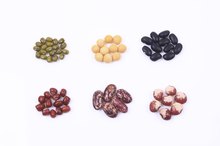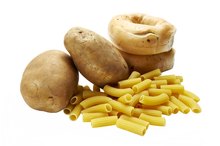Lightheadedness on the Paleo Diet
The Paleo diet is promoted as a diet built on what humans evolved eating during the Paleolithic period to help you achieve your optimal weight and health, according to Robb Wolf, biochemist and author of "The Paleo Solution." The Paleo diet is based on real, unprocessed foods, such as vegetables, fruits, nuts, animal fats and animal sources of protein. Dairy products, grains, legumes, including beans, lentils, soy and peanuts, as well as sugar are eliminated by Paleo dieters. The switch from a standard American diet to a Paleo diet can cause lightheadedness, headaches and dizziness in some people. Consult your doctor before modifying your diet.
Carb Intake
Lightheadedness and dizziness, especially upon standing or when exposed to heat, are usually due to the mild dehydration that can sometimes result from lowering your carbohydrate intake. While the standard American diet is based on carbohydrate-rich foods, such as breads, potatoes and sugar, the Paleo diet tend to be lower in carbs. A reduced carb intake can have a diuretic effect and can result in mild dehydration during the first few days of switching to a Paleo diet. Prevent or alleviate your feeling of lightheadedness by drinking plenty of water to stay properly hydrated while eating Paleo.
Paleo Diet and Carbs
List of Slow & Fast Carbs
Learn More
Although the Paleo diet tends to be lower in carbs compared to the standard American diet, the Paleo diet is not necessarily a low-carb diet. In fact, the carbohydrate content on the Paleo diet can be adjusted up or down depending on whether you need to gain, maintain or lose weight and depending on your physical activity level. If you need to lose weight and are not particularly active, restricting your carbs can help you reach your desired weight goal faster. If you are already at a healthy weight or are very active, increase your carb intake to ensure your body gets all the energy it requires without feeling lightheaded, dizzy or irritable.
Increasing Your Carbs
To prevent lightheadedness, increase your carb intake. You can do it for a few days just to help your body transition more gradually to a lower carb intake or decide to consume more carbs every day to fuel your daily activities. Choose carb-rich foods that are free of gluten, grains, legumes and sugar to comply with the Paleo diet principles. For example, potatoes, sweet potatoes, butternut squash, pumpkin, nuts and fruits are all very good sources of Paleo diet-friendly carbohydrates. Some Paleo dieters also include white rice or corn in their diet, as long as they are not intolerant to these grains.
Taking Enough Sodium
Can You Eat Crackers on a Low-Carb Diet?
Learn More
If you are keeping your carb intake lower than 50 grams a day while eating Paleo, you should include a bit more sodium into your diet to help your body retain enough fluids and prevent the mild dehydration that can cause lightheadedness. Add unprocessed salt, such as sea salt, celtic salt or Himalayan salt, to your foods or drink homemade salted bone broth. Your body will adjust to your lower carb intake within a few weeks and the lightheadedness and other side effects will got away.
Related Articles
References
- RobbWolf.com: Paleo Overview
- "The Paleo Solution: The Original Human Diet"; Robb Wolf; 2010
- "The Art and Science of Low Carbohydrate Living: An Expert Guide to Making the Life-Saving Benefits of Carbohydrate Restriction Sustainable and Enjoyable"; Stephen D. Phinney and Jeff S. Volek; 2011
Writer Bio
Aglaee Jacob is a registered dietitian. She has experience working with people who have diabetes, cardiovascular disease, hypertension and obesity issues. Jacob obtained a bachelor of science and a master of science, both in nutrition, from Laval University in Quebec City, Canada.








